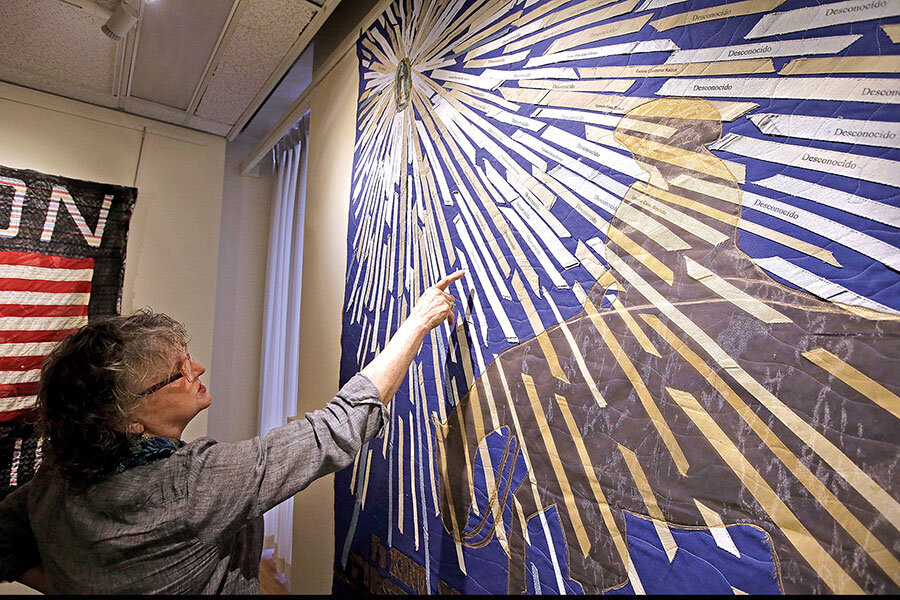With paint and patchwork, artists offer a new perspective on immigration
Loading...
Images of immigration are powerful, and artists across the United States are harnessing that power to help audiences understand the issue from a new perspective. At the Muzeo Museum and Cultural Center in Anaheim, Calif., a performance artist lies in a bed of mud. His prone figure evokes a death in the desert, perhaps along the US-Mexican border, perhaps in North Africa. Among the quilts exhibited across the country as part of the Migrant Quilt Project is one that includes an embroidered line reading, “Did you see a bird the day you died? Were you hot, thirsty, and frightened?” And John Moore’s 2018 book, “Undocumented: Immigration and the Militarization of the United States-Mexico border,” shows the military-style training US border agents receive, the warlike conditions Guatemalans fleeing drug gangs leave behind when they head north, mothers carrying children across the border, and US law enforcement agents carrying the bodies of migrants who perished, often from heat exhaustion. While the mediums vary, the works exhibit a common thread, a desire for awareness. As Denver artist Sarah Fukami says, “That’s American – seeing the situation for what it is and wanting to make it better.”
Why We Wrote This
As the immigration debate charges forward, artists are offering a different vantage point. Art provides a powerful and insightful – and safe – space to explore a topic as charged as immigration.
For a show Argentine-American curator Marisa Caichiolo mounted at the Muzeo Museum and Cultural Center in Anaheim, Calif., Cuban performance artist Carlos Martiel lay in a bed of mud. His prone figure evoked a death in the desert, perhaps along the US-Mexican border, perhaps in North Africa.
Ms. Caichiolo, who co-founded Building Bridges Art Exchange in Santa Monica, Calif., to foster cross-cultural understanding, was applying for US citizenship as she was organizing the show.
“I was becoming an American based on fear,” she says of her concern that her previous status as a green card holder might not protect her from deportation. Caichiolo became a US citizen in November.
Why We Wrote This
As the immigration debate charges forward, artists are offering a different vantage point. Art provides a powerful and insightful – and safe – space to explore a topic as charged as immigration.
Images of immigration can evoke many emotional subjects: global crisis and personal anxiety, history and identity, and life and death. They can even bring a touch of whimsy to a topic whose contentiousness is evident in debates, for example, over President Trump’s travel ban executive order that recently won Supreme Court approval in a 5-to-4 decision.
Loney Abrams, a curator and artist based in the New York borough of Brooklyn and editor in chief of Artspace magazine, says some artists respond to immigration “from a more political perspective. Some people are looking at the economic aspects. There’s other people who are looking at the social aspects.”
Ms. Abrams pointed to the collective known as Postcommodity and its “Repellent Fence,” an installation of 26 huge, brightly colored balloons that hovered over a two-mile stretch of the US-Mexican border in 2015.
Jody Ipsen founded the Migrant Quilt Project both to memorialize the hundreds of people who have died crossing the border in the desert near Tucson, Ariz., where she lives, and to spark conversation about immigration policy – and action. Peggy Hazard, an art historian and quilter who joined Ms. Ipsen’s volunteer team as curator, noted the long history of textile art being used to prick consciences in a 2016 paper titled “What the Eye Doesn’t See, Doesn’t Move the Heart.”
Among the quilts that have been exhibited around the United States is one created by Cornelia Bayley that includes an embroidered line reading, “Did you see a bird the day you died? Were you hot, thirsty, and frightened?” “It always makes me cry,” Ipsen says.
John Moore’s 2018 book, “Undocumented: Immigration and the Militarization of the United States-Mexico Border,” shows the military-style training US border agents receive; the warlike conditions Guatemalans fleeing drug gangs leave behind when they head north; mothers carrying children across the border; and US law enforcement agents carrying the bodies of migrants who perished, often from heat exhaustion. Mr. Moore also captured images from a Texas immigration detention center for children. A concrete-gray 2014 image in “Undocumented” shows a Honduran boy of 7 or 8 in a warehouse-like space sectioned into pens by chain-link fencing. A guard at the facility that then housed children who had arrived unaccompanied at the US border watched the boy watching a “Casper” video.
“A photograph is most powerful when it makes people feel,” the Getty photographer says.
Seven decades before Moore stepped into the detention center, Ansel Adams visited the Manzanar War Relocation Center in California to photograph Japanese immigrants and their American-born children. Adams published his photographs in his 1944 book, “Born Free and Equal,” saying they showed “loyal American citizens,” a challenge to arguments that Japanese-Americans were inherently dangerous because of their ethnicity.
Denver artist Sarah Fukami layers prints of Adams’s photos with images such as patterns reminiscent of Japanese woodblock print. Her work refers to the stories she grew up hearing from relatives about having been taken from their homes in Washington State, stripped of their property, and interned. Years after, Ms. Fukami’s grandfather fought in the Korean War for the US, a country that had once treated him as an enemy.
“The Japanese way is to continue with pride and to persevere and believe and honor that justice will win out,” Fukami said. “That’s American – seeing the situation for what it is and wanting to make it better.”







